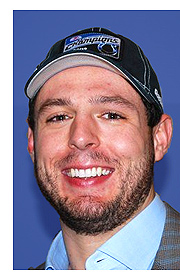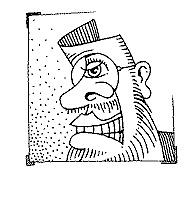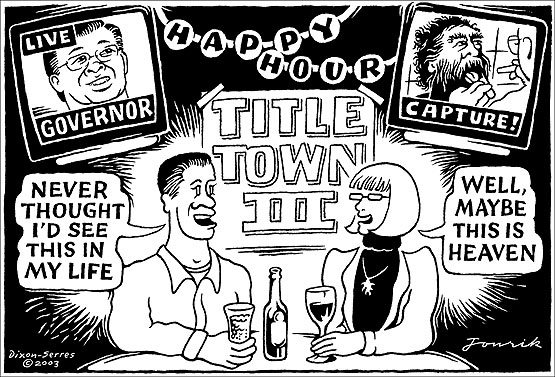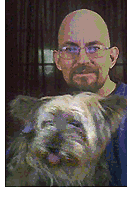Barley Meat Stew
2 quarts spring-house water
3/4 cup walnut juice
2-1/2 cups barley meat
1/2 cup mashed hedge apple
1/4 cup horsetail seed
1/4 cup Uncle Curly Tree berries
1/4 cup fine chicken dirt
garnish with chopped makko bird
Rescued from oblivion . . .
February 28th, 2010A Visual Journey — chapter the fifth
February 27th, 2010If my misaligned eyes had been straight and looked at the same object, then neurons carrying information from each eye would have delivered the same input to binocular neurons in my visual cortex. Since my eyes were not straight and saw different things, the binocular neurons in my brain received conflicting input. This situation set up a competition between my two eyes, and for each neuron, one or the other eye won out. Each neuron in my brain now responded to input from only one eye. My brain was wired in a way that prevented sterovision. While reading in college about “critical periods” in vision development, I had to conclude that it was too late for my vision to change. Yet, much more recent scientific research indicates that the adult brain may be more “plastic,” or capable of rewiring, than previously realized.
— Susan R. Barry, Fixing my Gaze
I went to the eye center early, before my fifth therapy session, to have a prism film applied to the right lens of my glasses. The prism corrects the misalignment to a limited degree, so I still must make an effort to fuse the double vision on my own. It’s a crutch of sorts, bringing images into a zone that deters my ingrained tendency to suppress the vision in one eye. Because of this, things usually look chaotic when I put on these glasses because they force my perceptions to deal with the lack of fusion. During therapy we had a bit of a breakthrough when Mary Ellen at last identified the precise configuration of prisms that seemed to provide for me vision that was fully singular. Pow. Suddenly I had a non-jumbled picture before me, without regard to head position or directional glance. But as appealing as that sounds, wearing this configuration of corrective lenses would do nothing to reverse the underlying brain-eye disorder. So the emphasis remains on integrated therapy, including a new pattern of exercises I do with a metronome. When I tried my first metronome task, I thought, “I don’t think I’ll ever be able to do this.” I kept at it, and when I noticed the first shade of progress, I experienced a startling shift in mindset— “I’m wrong. This is possible. For too long I’ve told myself that I can’t do things.” This awareness has now become the standard when a new exercise seems difficult. I don’t trust that initial feeling of insurmountability. Instead, I begin to anticipate some indication of partial success, and then I accept that daily practice will turn the tide. In other cases, the exercises have seemed too easy. I’ve learned to tell myself that there must be various kinds of neuron activity necessary to the overall brain rewiring. Easy or hard probably has nothing to do with it. At the sixth session, the “breakthrough” prism-set didn’t work at first, but then everything sort of snapped into place after a delay. I had noticed this phenomenon before when using the “crutch glasses.” Clearly there is more to this than getting a new pair of spectacles. It’s more like acquiring a new wiring diagram for my gray matter, synapse by synapse.
Who dat?
February 7th, 2010There have been years in the past when I couldn’t have told you the teams competing in the Super Bowl, even if the fate of my eternal soul had depended on it. Fast forward to today, when I awaited the big game with immense anticipation. What changed? First of all, I spent enough time with a great football-watching friend to understand that NFL players are the most amazing athletes in the world.  And then, when Bruce was gravely ill and we spent a good portion of a year hanging out around Indianapolis, I began to favor the Colts. The clincher took place last year, when I worked professionally with local star Jacob T, a second-year back-up tight end and special team starter for the team, following his brilliant career at the University of Kentucky. After that I was hooked on Indy, deriving much pleasure from watching their “almost-perfect” season and playoff success. Nevertheless, despite my desire to see Jacob be part of a Super Bowl victory, I’m not sad that the Colts fell short against the Saints tonight, because my heart is with Kristi and the Hornsby family as they enjoy a wonderful celebration in New Orleans.
And then, when Bruce was gravely ill and we spent a good portion of a year hanging out around Indianapolis, I began to favor the Colts. The clincher took place last year, when I worked professionally with local star Jacob T, a second-year back-up tight end and special team starter for the team, following his brilliant career at the University of Kentucky. After that I was hooked on Indy, deriving much pleasure from watching their “almost-perfect” season and playoff success. Nevertheless, despite my desire to see Jacob be part of a Super Bowl victory, I’m not sad that the Colts fell short against the Saints tonight, because my heart is with Kristi and the Hornsby family as they enjoy a wonderful celebration in New Orleans.
A Visual Journey — chapter the fourth
February 6th, 2010When I undertook optometric vision therapy at age forty-eight, I could see the misalign-and-suppress mechanism at work in my own visual system. With therapy procedures, I learned to bring the images from both eyes into consciousness and could therefore discover where my two eyes were aiming. Throughout life, an unconscious action had moved the image from one eye out of alignment, making it easier for me to discount the image from the nonfixating eye.
— Susan R. Barry, Fixing my Gaze
Yesterday I had my third session with Mary Ellen, the therapist selected to work with me on a program of weekly eye exercises. The disciplines are both challenging and tiring. Let me explain that. They are difficult because they necessitate a kind of exertion unlike physical or mental effort. Nevertheless, it does involve muscle and brain activity, which is tiring, but the kind of fatigue that results is unlike anything I’ve known—a dull pressure in the middle of my head. I don’t feel exhausted, but noticeably depleted in a way I can’t put my finger on. So far, any progress I’ve noticed has made me even more aware of the dysfunction. In other words, the double vision is more obvious at times because I’m training myself not to suppress the vision in one eye to accommodate the misalignment. Does that make sense? It’s frustrating and stressful to have my vision more chaotic, but I understand the need to strengthen my singular vision in each eye before I develop an improvement in its ability to “team.” This will require more fusion exercises that rely on 3D glasses. I also have to do daily patching for individual-eye isolation work. It’s probably best that I avoid “overthinking” all of it and concentrate on applying myself to the assignments. I don’t know what I’d feel if I didn’t have confidence in the benefits of the process.
A Visual Journey — chapter the third
January 21st, 2010Our conventional and limited view of adult neuronal plasticity derives in part from the specific ways that scientists and physicians have designed laboratory experiments and clinical therapies. We cannot understand neuronal plasticity by studying brain circuits in isolation from the whole person. Only by considering a person’s adaptations and response to her condition can we really explore the amazing plasticity of the human brain to rewire itself throughout life in order to recover from injury, learn new skills, improve perception, and even gain new qualia.
— Susan R. Barry, Fixing my Gaze
Susan Barry’s book is certainly not for everyone, but like many works that explain a long misunderstood aspect of human health, reading it has been invaluable to someone who must personally face the unknown, accept a daunting challenge, and believe that one’s own body has the capacity to respond positively to a holistic, self-corrective discipline. I’m thankful that the book was recommended and glad that I read it before undergoing my first therapy session tomorrow morning at the Vision and Learning Center. I feel fully committed and as prepared as possible for 30 weeks of treatment. I’ve placed my confidence in people who might be dismissed as charlatans by some medical specialists, but that’s nothing new for me. I even heard a top expert on the Charlie Rose Brain Series recently insist that there is a “critical period” during childhood that governs the development of visual perception, which makes it impossible to correct some eye disorders later in life, a misinterpretation of research that Barry says has been long discredited by scientists and vision therapists. Well, I’m about to conduct my own experiment, under the guidance of individuals I consider to be knowledgeable, trustworthy professionals, and I’m eager to get started. Enough preliminaries! I’m fortunate to have the Center within a reasonable driving distance. Sure, I wish it wasn’t so dang expensive, but isn’t that why The Guy in the Sky grew plenty of oak trees on my knobs? Onward…
A Visual Journey — chapter the second
January 13th, 2010A strabismic’s eyes are not aimed at the same point in space. The difference between the left- and right-eye views is too great for the brain to combine the images into a single picture. A person with non-aligned eyes is confronted with a serious perceptual problem; she must somehow create a single, coherent worldview from conflicting input from the two eyes. To solve this problem, many strabismics suppress the information from one eye and look through the other. Some always use the same eye, while others continually switch between the two eyes, but in either case, they may never see normally through the two eyes together. As a result, most strabismics have reduced or absent stereovision.
— Susan R. Barry, Fixing my Gaze
Spending time with the View-Master as a child was a deeply moving experience. But, after all, it was just a toy, and I was embarrassed enough about my strong emotional responses that I kept them to myself. I recall being so affected by the Flash Gordon reel that knowing there was a finite limit of images nearly brought me to tears. What was it about seeing those 3D impressions that was so profound? Was it because my natural depth perception was already deficient or in decline? I knew I wasn’t very good at hitting or catching a ball. Did I simply lack an athletic reflex, or could it have had more to do with an inability to place objects in space, a known characteristic of monocular vision? How flat has my world been all along?
Yesterday I went to the Vision and Learning Center for a battery of diagnostics that measured and benchmarked the current state of the eye disorder. I’m starting to get more comfortable with phrases like a) Vertical Strabismus (eyeballs out of alignment), b) Oculomotor Pursuits (something to do with how cognitive function enables the eye to move smoothly), and c) Binocular Fusional Disfunction (inability of brain neurons to coordinate dual-eye vision). Actually, it’s wrong to think of it as an eye problem. A “brain glitch” is probably a more accurate way to understand it. Some of the tests seemed ridiculously easy, while others were very difficult and exhausting for me to perform. At the end of my session came a discussion about the details of therapy, timetable, and costs. Once-a-week sessions at the Center for 30 consecutive weeks, plus daily home practice, 30 minutes minimum. For some reason, I wasn’t expecting such a long program, and the sticker price knocked me for a loop. I left with doubts about whether I could take on the economic commitment, even though I knew I had enough discipline to make the approach work. Dana and I had a long discussion. We kept arriving at the same conclusion: I simply had to get this fixed, and somehow we would manage our finances to pay for it out of pocket.
Awesome?
January 11th, 2010Tonight was the most enjoyable hour of Chuck that has ever aired. Might have made it worth sitting through all those lousy ‘Buy More’ episodes. NBC probably wishes it still had Life and Journeyman on the shelf, now that the Leno-at-10 idea has collapsed.
A Visual Journey — chapter the first
January 9th, 2010I’ve made entries before that allude to my progressive vision problem, but I’ve only now decided to formally record some of my experiences during this new year, when I undertake a therapeutic course of action. While learning about this disorder—a form of misalignment generally known as strabismus—I may need to correct some of the information conveyed, as I gain greater or more specific knowledge. At first, I recall noticing an odd head position and disturbing look in my eyes when I closely examined photos of myself. Initially I could dismiss it as an aberration, or comfortably deny that anything meaningful was indicated. Eventually, I came to accept it as my “pirate eye,” and began to avoid looking at others with a leftward glance, which seemed to bring the misalignment into play. Joan mentioned her optometrist to me, but I wasn’t prepared to seriously tackle the situation. By and by, more realizations that the condition was getting worse convinced me I could no longer put off the idea of professional intervention. Dr. Graebe turned out to be a highly capable diagnostician and engaging clinician. He said that I had already lost 60% of my depth perception, with a deficient ability to process uncoordinated binocular movements. Every symptom I described seemed to just reinforce the obvious for him, and I was mildly surprised that I didn’t have some unique or difficult to define condition. And so he prescribed “vision therapy,” based on the awareness that my root problem is not muscular, but involves the brain’s ability to make sense of neurological input from two organs—our source of three-dimensional vision. In addition to setting up an appointment with the Vision and Learning Center, he urged me to read Susan Barry’s Fixing My Gaze. I’m sure it’s not unusual for a person with a health challenge to discover that his or her malady has been ably explained by an author who has faced the same situation in life. Although I still don’t understand the full implications of taking on the discipline of vision therapy, starting the book has triggered numerous memories and personal observations about my sensory experiences since childhood. Dr. G had been particularly struck by my statement that I knew from an early age I was a two-dimensional thinker, preferring the flat surface over volumetric or architectural forms. It caused me to think about whether I have ever possessed “normal” depth perception. For the longest time, foreshortening has bedeviled me as an artist. I’ve always been a slow reader, never been a good driver, nor been favorably inclined to certain eye-hand motor skills, even though it’s clear I had a natural manual dexterity from the beginning. As a marksman, I excel at single-eye target shooting, but ask me to hit something on the move with a shotgun and the results prove embarrassing.  Saddest of all is when I realized that the awe of star-gazing had slipped away, as my ability to perceive the dimensionality of the night heavens declined. The optimistic hope for improvement, given the functional plasticity of brain neurons, is emphasized by both Susan Barry, Dr. G., and Debra (my therapist). I accept that, in spite of having no comprehension of the difficulties that lie ahead, or how “one must learn to align the eyes and fuse their images, while unlearning the unconscious habit of suppressing vision, which has been occurring perhaps for decades,” or how therapy “requires high motivation and self-awareness, as well as enormous perseverance, practice, and determination.”
Saddest of all is when I realized that the awe of star-gazing had slipped away, as my ability to perceive the dimensionality of the night heavens declined. The optimistic hope for improvement, given the functional plasticity of brain neurons, is emphasized by both Susan Barry, Dr. G., and Debra (my therapist). I accept that, in spite of having no comprehension of the difficulties that lie ahead, or how “one must learn to align the eyes and fuse their images, while unlearning the unconscious habit of suppressing vision, which has been occurring perhaps for decades,” or how therapy “requires high motivation and self-awareness, as well as enormous perseverance, practice, and determination.”
We shall see…
“Jonrik” is no more . . .
January 8th, 2010
This is the last image I created in a partially successful effort to provide “cartoons to the editor,” in partnership with my pal, Rick. It’s from 2003, when several improbable events converged: Kentucky elected the first Republican governor in a generation, Saddam was captured in Iraq, Boyle County and Danville football teams concurrently won state championships for the third time, and local voters passed a liquor-by-the-drink ballot measure. The cartoon was rejected for unknown reasons. In retrospect, it does seen to violate one of the basic rules of editorial drawing— focus on a single, easy-to-grasp idea. Oh well, I still like that style, but it was too much work to continue for free.
2010 — Empty nest?
January 7th, 2010
“Time for you to leave…”
— Master Kan
Various & Sundry, part eighty-four
December 31st, 2009— Year of 2009 workout totals: Swim-43; Bike-38; Run-1; Lift-3; Pilates-16; Lupus Drill-3
— Back spasms and muscle injuries shut down my gym time early in the year, and I never could recapture the momentum. Eventually had to curtail the Pilates work, too, but assigned myself an improved swimming and cycling pattern. Running played no part in the annual effort. My new hope is that 2010 will take on a more balanced character, otherwise my long-held exercise habit could turn into a flab-it.
— An even more regular fitness regimen is on my list of New Year’s resolutions. I also need to:
• Partake of the great writers—
Conrad, Hugo, Dickens, plus more Hemingway, Kipling, Tolstoy
• Gain new levels of skill with hand, eye, and mind—
Brush Stroke, Graver Line, Digital Effect, Options Trade, Chess Move
• Spend more time in the knobs with Marty
• Take Dana to the west coast — somehow . . .
— Another year has passed, and it is ever gratifying to create things which satisfy one’s own artistic urge, while promoting commercial activity that helps provide abundance and livelihoods to others. But, as always, it is never pleasant to continually justify the role of the design professional in an environment of declining visual literacy, where everyone can stand their uninformed, subjective ground to affirm the inappropriate, or declare that mediocrity is “good enough.”
— An unexpected viral assault has threatened my long-anticipated year-end participation in Louisville, but a counter-barrage of immune system boosters is under way, and, so far, I successfully made it to the city intact for the wonderful rehearsal dinner last night. The final day of the year is a bedridden affair, with fifteen back-to-back Twilight Zone episodes to suitably infuse the atmosphere with surreality.
To Caitlan and Kyle— Happy New Year!
J O H N
December 27th, 2009Fisherman, Disciple, Evangelist, Visionary

“. . . peace to men on whom His favor rests.”
December 26th, 2009“To be politically correct, I can say
that I’m scoping out the Norwegians
when I get on a plane, but face it,
if there’s a shaky Muslim cat near me,
I’m going to be keeping my eye on him.”—Dennis Miller
News of a thwarted terrorist act has popped the bubble of holiday euphoria, and yet, to maintain a festive mood is remarkably easy for those of us who weren’t called upon to celebrate Christmas by clambering over an airline seat to subdue a suicidal fanatic.
Yesterday morning found us at Terie and Marty’s for Christmas brunch gift giving. After arriving home we had some private time (I got a new bicycle helmet from Santa), before relaxing with afternoon victuals, enjoying the company of our dear friends, David and Lee, and a sensational Sonoma County Zinfandel from Dana’s brother Bill. A trip to Lexington followed, where we watched the new Eastwood picture and shared our evening at The Pub. Not surprisingly, “Invictus” pushed my buttons, but the editorial pacing of the World Cup championship match fell a bit short of my expectations. In any case, Freeman’s portrayal of Mandela was outstanding, and it’s my understanding that he has wanted to play the character for many years, having brought the adaptation to Clint while developing the property himself.
Today is Boxing Day, so it’s off to Kelley Ridge for more conviviality. Things just keep getting better during this splendid countdown to a landmark New Year’s Eve wedding in Louisville!
Eventidings
December 24th, 2009Our Christmas Eve celebration with Clan is over. Joan captures it best.
Earlier today I was trying to locate a print for us to give as a gift and ran across a collage that I barely remembered creating. Interestingly, I was not overly impressed, although I had to admit the piece is visually striking. So much of my life involves the effort to exact compensation for my creative abilities. My impressions have given rise to the typical holiday-season musings:
First thought . . .
I’ve neglected mixed media for inappropriate reasons.
Second thought . . .
My original investigations were unrelated to economics.
Third thought . . .
I must reject any temptation to invite commercialism.
Fourth thought . . .
I am capable of pushing this medium beyond previous levels.
De jure belli ac pacis
December 8th, 2009I was disappointed to discover that my copy of War and Peace is “edited for the modern reader.” Should have realized it much sooner, since it’s “only” 741 pages long. Nevertheless, I’m feasting on the translation with immense pleasure, while at the same time skimming General Armand de Caulaincourt’s memoir, With Napoleon in Russia. I don’t know why I dart around like this, just when I was beginning to take a new interest in the American Revolution. Perhaps this will bring me around again to our second war with Great Britain, or a fresh look at Tecumseh. 1812 was certainly a landmark year, and right at the heart of my favorite period in our national story. I shall never exhaust my curiosity with this era. But here’s the real question— How can I turn my attention away from the works of Tolstoy? He understood, as Shakespeare did, just about everything there was to know about anything.
Team approach
November 7th, 2009I’ve come to the end of a outstanding week that began last Friday when I headed to Monterey for my fifth workshop with Wesley Bates. I didn’t pitch a tent this year, but had the familiar loft at Larkspur Press to myself each night. The opportunity to concentrate on wood engraving for three days in that extraordinary environment made sleeping on a wood floor seem like the ultimate in accommodations. I continue to learn more about the art form with every retreat, and I now face the breakthrough act of finally acquiring my own set of customized tools, so I can maintain a year-round practice to replace my once-a-year introductory learning curve. On Saturday night, Wes, Juanita, Leslie, and I drove over to Hanna’s “house concert” by Kraig Kenning, at the home Prajna Design created for her (builder Garry Murphy was there, and I chatted with him). I’m prepared to say that Kenning is the best steel guitar performer that I’ve heard live (and I once watched David Lindley tape a Soundstage concert with Jackson Browne in Chicago). An enjoyable nightcap with Wes extended deep into the night as both of us discovered that we have even more in common as creative professionals. It was nice this time around to balance social enjoyment with lots of one-on-one time with Wes.
The subject of my block was a pair of handsome mules that worked the Realm of Greystone when James brought in low-tech loggers after the ice storm of 1994. I managed to get some decent slides while they were in the Valley—undoubtedly the last high-level transparencies I may ever take. It wasn’t a bad note on which to end my slide-shooting era. I’ve always wanted to begin exploiting those images for my art, and so I selected a shot of two mules with the tobacco barn in the background (a suitable tribute to the recently fallen landmark). My goal was to chose a style that would enable me to complete the block and print it within the weekend constraint, and that meant consulting with Wes about how to use an approach that didn’t rely on time-intensive technique (the path I found myself on last year, resulting in a missed deadline). I may not ultimately like “Logger’s Team” as much as my 2008 print, but I learned much about the medium, with a big step closer to understanding the elegantly minimal line quality that Bates has truly mastered.
Last night I headed north again with Dana and Joan for Richard’s First Friday event in Old Frankfort. Wesley’s wife, Juanita Wilkins, performed and Richard read poems from his new volume about Abraham Lincoln (commissioned for the bicentennial observation). Everything about the evening was splendid, and there was a magical moment when the unknown “Harmonica Man” appeared from nowhere with his “harp belt” to jam with Juanita. I’ve been so fortunate to hear her a number of times now, and she never sounded better to me than last night; nor had she conversed with her audience so impressively or in such a personally revealing way. Absolutely wonderful…
Support and resistance
October 30th, 2009“The chief cause of stress is reality.”
~ Lily Tomlin
It’s hard to accept that nearly three weeks have flown by since Dana and I were traveling to North Carolina, bearing the brunt of a devastating tempest that left 35 homes “unlivable” in Casey County (based on information I learned through the Salvation Army). Since that stormy day I had two wonderful weekends with family at both Broadwing and Blue Bank Farms. Carol and Bob are as youthful as ever and at the pinnacle of insight. Shame on me for taking five years to make a return visit. I was delighted to see how they had displayed my drawing of the old barn, and Pete showed off my pen and ink sketch of the Vulcan stove from their early years above the French Broad. I couldn’t help but contemplate the decline in my sketchbook activity over the past year. During my two days at the Hall, I made an attempt to complete work on the rock flue, but ran into mortar problems again while battling Panyon’s tool thievery. My “Son of Dirk Man” character was a bit of a flop, compared to Jay’s Pappy, Mombo’s Rufus, and Clay’s Donkey Kong. Nevertheless, the day was noteworthy for the revival of our Clan Hayride—a “harvest jamboree,” as Joan called it—and also for her tip about Pandora.com. The Council voted to commission an illustrated map of Clan Valley. Wow, how do I come up with an estimate for that? (Lord, help me finish it quicker than my stone masonry!) Dana called me from town to break the news that our friend Irina had been discovered lifeless, the apparent victim of a heart attack. She was a year younger than me! It took four or five days for me to grasp the finality of losing her awesome talent. Early Sunday morning I decided to tote my Hawken-style 50-caliber down the Valley in search of venison. The ache of a gifted comrade’s passing was on my heart when treetops dipped to let the sun pour its precious gold into our beloved hollow. The goal of hunting for meat dissolved abruptly to a deep reverence for the beauty of our rural legacy and my gratitude for life. When I got up to move farther along the road, something caught the corner of my eye. Four good sized does were now moving purposefully across the hay field. Before I could swing my muzzleloader into play, all were into the wooded drainage. If I’d only lingered a minute more, I probably could have had my pick. The following days were tainted with sorrow, but the request to create Irina’s memorial keepsake helped me channel my emotion, although, sadly, the local printer once again seized the opportunity to complain about our predicable attention to detail. By week’s end, the fabulous distraction of sharing Rick H’s 50th birthday celebration was trumped by the news of Glenda’s bizarre mishap at the Haunted House, which resulted in her breaking four back bones. And this comes on top of her and Jay dealing with the aftermath of burst plumbing and extensive damage to their newly remodeled home. The Graybeard Prospector had the second of two successful networking sessions in Lancaster, and Sunday Silence at Simpson Knob was another welcome break, but the heightened oscillation of desirable and undesirable happenings is becoming too strange. All I want to do is immerse myself in the upcoming wood engraving workshop at Larkspur and try to take myself back to a point of quiet equilibrium. Well then, load the truck and go!
October 17th, 2009

†
Irina Ilina
a dear friend
an extraordinary artist
R
I
P
All Yorkies go to heaven
October 12th, 2009 Bruce lost his canine companion today when the merciful thing to do became his only option. Our brief account begins in 1999 when Walie had her only two pups, Whitley and Winslow. Little Whitley found years of exceptional living at the exalted Yorkshire Estate before his tragic and premature demise this summer. Over-sized Winslow went to Bruce, but disappeared at a social event and was never seen again. Fortuitously, a generous couple aware of Bruce’s loss offered him an older Yorkie that was a near double of Winslow in both appearance and disposition. His name was Boozer. Bruce changed his name to Hoosier, but it always sounded like Hoozer when I said it. He provided great comfort to his master during a period of traumatic pain and hurtful circumstances, squeezing every drop of life from his span of existence. So long, buddy.
Bruce lost his canine companion today when the merciful thing to do became his only option. Our brief account begins in 1999 when Walie had her only two pups, Whitley and Winslow. Little Whitley found years of exceptional living at the exalted Yorkshire Estate before his tragic and premature demise this summer. Over-sized Winslow went to Bruce, but disappeared at a social event and was never seen again. Fortuitously, a generous couple aware of Bruce’s loss offered him an older Yorkie that was a near double of Winslow in both appearance and disposition. His name was Boozer. Bruce changed his name to Hoosier, but it always sounded like Hoozer when I said it. He provided great comfort to his master during a period of traumatic pain and hurtful circumstances, squeezing every drop of life from his span of existence. So long, buddy.
Les Cheneaux report
September 26th, 2009

Morning on Moscoe Channel | Barefoot’s Resort | Les Cheneaux
• Marty and I are back from the first vacation the two of us have taken together. We coaxed unhappy Ned all the way to Tipp City on the Saturday before Labor Day and left for Michigan’s Upper Peninsula with Bill the following day. I’ve made many entries about Barefoot’s Resort in this log. I don’t intend to rerun the details, but you know how much I find to love about that setting. Add to that many satisfying experiences with my grandson from this most recent trip.
• My weather report is great— warm and sunny during the day, cool and refreshing at night. The clear sky displayed an awesome starscape, as the breeze laid down almost every night before a brilliant moonrise over the reflecting channel. I wish I could make a similarly positive report about the fishing. Caught enough yellow perch and northern pike to provide a nice taste, but no cooler was packed with frozen fish for the return home. Our only attempt at lake salmon was a strikeout. The era of bountiful Chinook is gone, everyone seems to agree. Nevertheless, Marty had his chance to pilot the Sylvan as I worked the familiar stern down-riggers with Foot, my generous friend.
• Glad to say that I got in my hoped-for endurance swimming. People told me the water was cold when we first arrived, but I soon learned that their perspective was completely different from mine. I didn’t need a wet suit for the first few days. Never having been in the water on a busy holiday, I did make Bill nervous on Monday when I paused twice on my channel crossing to accommodate boat traffic. He was having unpleasant visions of “collecting body parts.” I pledged to be more cautious for the rest of our stay. Sure, I want to keep fit, but I can’t help but think that part of why I like certain activities is that it puts me in touch with a younger, more naive self — especially that little guy who would put a rubber knife in his teeth after watching a Weissmuller flick and take off at full speed across the backyard (without shirt, shoes, or a care in the world).
• I have made this retreat with Bill during most Septembers since 1993. Although Dana and I traveled to the destination with Marty years before, it was different to share the experience on the eve of his turning 18. It was a unique opportunity. Another exceptional part of our getaway was the first visit of my old high-school chum Greg B, who I haven’t seen since 1980. A highly successful pediatrician in Columbus, Ohio, Greg lost the mate of his life last year after her long battle with cancer. We had several profound conversations—true moments of soul contact—that I wouldn’t trade for anything in the world. Nothing has ever put me in greater appreciation of my own partnership of love, nor helped me glimpse the sorrow of losing a spouse—not even my dear sister’s double devastation. It was a rare, man-to-man insight that I simply can’t put into words.
• A time apart with good friends, and with a lad who holds an exclusive place in my heart. A time suspended, close to the earth and the heavens. On the water, in the water, under the water. Gazing into the wood flames, with the sun’s heat still pulsing across my skin, and the countless points of fire shifting overhead. I shall remember. I shall return.

The virtues of nonvirtuality
September 5th, 2009It’s great to keep up with your friends on facebook, but we must not neglect true fellowship in close proximity. Therefore, I travel to Upper Michigan with grandson Marty to be with good pals ~ to swim, fish, draw, and have fun. On to Barefoot’s Resort!

